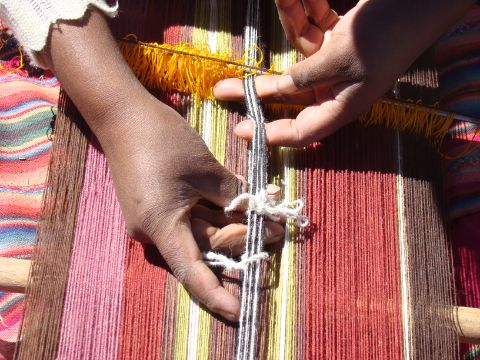
Lifting up the warps with the heddle, Isla del Sol, La Paz, Bolivia, 2008. Photo: Elvira Espejo Ayca
Pallaña and pallay are Aymara and Quechua terms for the predominant mathematical rhythm of a warp, which is the key to generating different textures and composing iconographies, i.e. figures. This process entails carefully counting the warp yarns based on rhythmic patterns such as 11111111, 1212121, 2222222, 3333333, or 4444444. These mathematical sequences are crucial to designing and producing both the figures and the textures of the fabric, and can be found in all weaving practices across the Andes from the north of Argentina and the north of Chile to the Andes of Bolivia, Peru, and Ecuador and right up to the mountains of Colombia. As there has not been much research into pallaña, this text seeks to open up our understanding of woven fabrics to embrace knowledge about the mathematical forms that transcend borders while reflecting local languages.
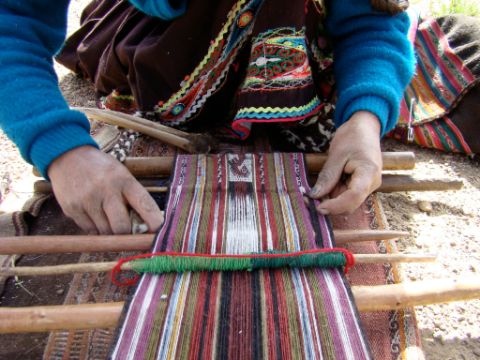
Compressing warps in pairs with a wich'uña (a weaving tool made of llama bones), Qaqachaka, Oruro, Bolivia, 2007. Photo: Elvira Espejo Ayca
Palla and woven composition
Without a mathematical structure it would not be possible to create either the iconographies or the textures typical of this woven fabric. At the same time, the Aymara term quchuña specifically refers to the mathematical composition of warps required to construct an iconographic figure. To achieve this, it is indispensable to have a grasp of numerical concepts such as addition, subtraction, multiplication, and division. Only with this mathematical understanding can we arrange the warps required to create a figure.
Understanding how the warps are composed, depending on the technique selected, is fundamental. In Aymara there are specific terms to describe the mathematical operations applied to the warps, depending on the rhythm selected. Wakthapiña, for example, refers to adding the warps, while jiwantayaña involves subtraction. Mirattayaña requires multiplication and t’aqantaña calls for division. These operations, always governed by a pre-defined mathematical rhythm, are essential to creating the specific textures and figures in the woven fabric.
The concept of palla, which means a mathematical rhythm based on the predominant numerical pattern, has variants, for example in maya palla, where the sequence 1,1,1,1,1 generates a texture ideal for composing set figures. By contrast, in ch’ulla palla the sequence 1,2,1,2,1,2, generates diagonal textures typical of the Andes, because the sequence is governed by odd numbers. Paris palla, meanwhile, uses the sequence 2,2,2,2,2, which creates dot-shaped textures. These mathematical rhythms do not simply define the textures; they are indispensable for composing figures and iconographies, which are essential elements in the Andean art of weaving. Without that mathematical structure, it would be impossible to conceive the complex iconographies that bring life to textile traditions.
Mathematical weaving operations: the basis for creating figures
Once we are familiar with these mathematical rhythms, descriptive terms enable us to look more deeply at the composition underlying the fabric. The next step invites us to explore the palla, which is the predominant mathematical rhythm based on numbers and technique, a crucial element in weaving. The palla always relates to the way the warps are counted, either by simple units or by even or odd numbers. This numerical predominance generates specific textures that are essential to each technique and permit the creation of iconographies. For example, it entails the selection of warps, colours, or shapes required by the design. We need to understand how it works in the selected technique, say, with a sequence like 1,1,1,1,1; 2,2,2,2,2; or 1,2,1,2,1,2. These textures lead directly to the iconographic composition within the proposed texture. As already mentioned, this process combines mathematical operations such as addition, subtraction, multiplication, and division, all of them extremely important in constructing a textile iconography. Without that mathematical basis, no figure would work out.
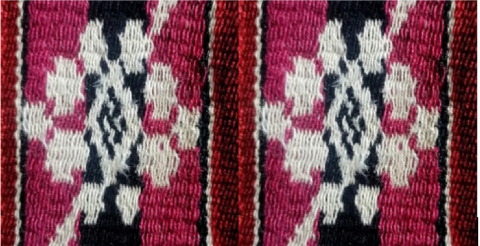
Maya palla: the mathematical warp rhythm 1,1,1,1,1, 2024. Photo: Elvira Espejo Ayca
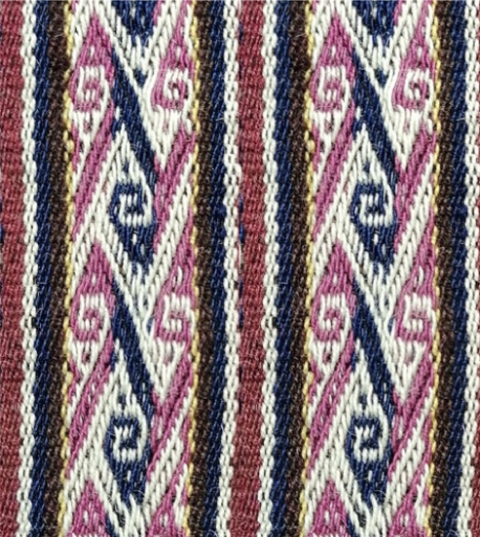
Ch’ulla palla: the mathematical warp rhythm 1,2,1,2,1,2, 2024. Photo: Elvira Espejo Ayca
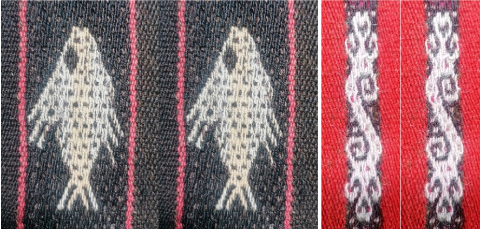
Paris palla: the mathematical warp rhythm 2,2,2,2,2, 2024. Photo: Elvira Espejo Ayca
For weavers, another crucial factor in their practice is the number of warps: whether they are simple, complex, or whatever mathematical pattern predominates. In this context, almost nothing is said about what the iconography means. Instead, there is a deep analysis of the composition and its mathematical complexity. That is why the palla is fundamental, because it links all the mathematical rhythms required to compose textures in the textile object. Through this deep reading of the mathematical composition, we see the palla as the pivotal axis in the creation of the fabric. It reflects ancestral knowledge of how mathematics is applied to the weave.
For example, the concept of mayat mirayaña means increasing the warps unit by unit, moving one by one along the warp threads. By the same token, payat mirayaña refers to increasing the warps in pairs, a process that facilitates their multiplication and broadens the options for composition in the fabric. By contrast, mayat jiwathapiyaña means decreasing the warps unit by unit, a procedure for subtracting warps from the fabric. In turn, payat jiwathapiyaña focuses on reducing the warps by pairs, which results in removing or losing warps in the design. These two reduction techniques are essential to composing the figures and the textures and balancing out the mathematical compositions.
Following the same logic, ch’ulla thakini is the pattern chosen for odd numbers, with sequences like 1,2,1,2,1,2,1, which generate a diagonal texture known as thakhini or ‘paths’. These diagonals, created by the mathematical rhythm, guide the warps, indicating whether they should move to the left or to the right. It is as though the warps are signalling a direction by means of the mathematical composition: because of the odd numbers, they set a pattern that maintains the rhythm and composes iconographic structures, balancing them out with techniques like ch’ulla thakini.
Then there is thakhip arktaña, which is also part of this mathematical structure of odd numbers, which steers the warp diagonals like a mathematical guide. Without that guide it would not be possible to shape a figure. That is why we are constantly aware of the direction of the warps. For example, ch’iqhar mirayaña means orienting the warps towards the left, while kupir sarayaña turns them towards the right. These directions do not simply help to increase or decrease the warps, but are also fundamental to creating the iconography, as they allow us to work on the composition of the figures and the balance in the texture.
The aim of all this composition is to make the iconographies grow and repeat in the desired format. In this context, wakhuña, which means counting, is crucial. Without counting the warps, it would not be possible to compose an iconography or to generate the texture that is the result of the technique and the predominant numerical pattern in the warps. Mayat wakuña or ch’ulla wakhu means counting warps by unit, where using odd numbers might follow a sequence like 1,1,1,1 or 2,1,2,1. These counts are essential because thanks to this mathematical complexity we start to compose the iconography and the figures. By contrast, payat wakhuña or uka ma chinu means counting with even numbers, and every pair of warps is treated as a chinu, a family of two companions, like a husband and wife, generating all the dynamic increases and decreases that allow us to create the figure across the texture. Qhachit wakthapiña means counting warps by layers. These crossed warps are always counted in pairs, which work in tandem to create the texture and iconography. This crossing relates to the mathematical composition, generating a connectivity of numbers across the warps, which allows the creation of figures.
This is the new way for weavers to understand and generate a distinct perspective. Instead of simply studying the superficial beauty or meaning of the iconographies, they see how mathematics, through the rhythms of addition, subtraction, multiplication, and division, is fundamental to composing the iconographies and working the shapes.
We as weavers are constantly reading the texture of the warps, which reflects the predominant mathematical principle and constitutes a technique. After that, we work on composing the figure, i.e. on how the mathematical rhythm (adding, subtracting, multiplying, dividing) contributes to the woven composition. In our work there is no predetermined iconography before the weaving begins. What we work on is the number of warps, their composition, their complexity, and the predominant technique based on counting and mathematics.
Translated from Spanish by Katherine Vanovitch